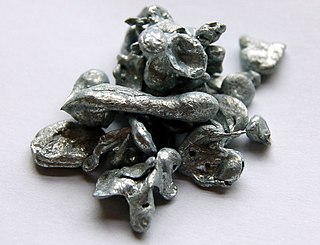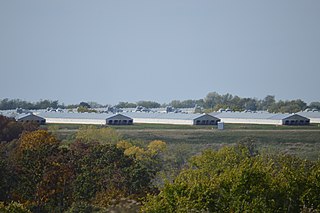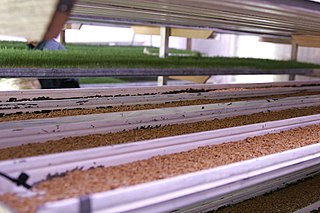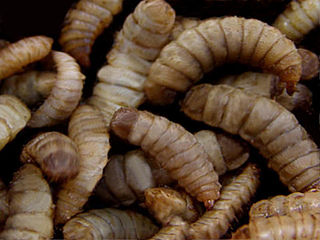 W
WAnimal feed is food given to domestic animals, especially livestock, in the course of animal husbandry. There are two basic types: fodder and forage. Used alone, the word feed more often refers to fodder. Animal feed is an important input to animal agriculture, and is frequently the main cost of the raising animals. Farms typically try to reduce cost for this food, by growing their own, grazing animals, or supplementing expensive feeds with substitutes, such as food waste like spent grain from beer brewing.
 W
WChelates in animal feed are organic forms of essential trace minerals such as copper, iron, manganese and zinc.
 W
WIn animal husbandry, a concentrated animal feeding operation (CAFO), as defined by the United States Department of Agriculture (USDA), is an intensive animal feeding operation (AFO) in which over 1,000 animal units are confined for over 45 days a year. An animal unit is the equivalent of 1,000 pounds of "live" animal weight. A thousand animal units equates to 700 dairy cows, 1,000 meat cows, 2,500 pigs weighing more than 55 pounds (25 kg), 10,000 pigs weighing under 55 pounds, 10,000 sheep, 55,000 turkeys, 125,000 chickens, or 82,000 egg laying hens or pullets.
 W
WFeed manufacturing refers to the process of producing animal feed from raw agricultural products. Fodder produced by manufacturing is formulated to meet specific animal nutrition requirements for different species of animals at different life stages. According to the American Feed Industry Association (AFIA), there are four basic steps:Receive raw ingredients: Feed mills receive raw ingredients from suppliers. Upon arrival, the ingredients are weighed, tested and analyzed for various nutrients and to ensure their quality and safety. Create a formula: Nutritionists work side-by-side with scientists to formulate nutritionally sound and balanced diets for livestock, poultry, aquaculture and pets. This is a complex process, as every species has different nutritional requirements. Mix ingredients: Once the formula is determined, the mill mixes the ingredients to create a finished product. Package and label: Manufacturers determine the best way to ship the product. If it is prepared for retail, it will be “bagged and tagged,” or placed into a bag with a label that includes the product’s purpose, ingredients and instructions. If the product is prepared for commercial use, it will be shipped in bulk.
 W
WFodder, also called provender, is any agricultural foodstuff used specifically to feed domesticated livestock, such as cattle, rabbits, sheep, horses, chickens and pigs. "Fodder" refers particularly to food given to the animals, rather than that which they forage for themselves. Fodder includes hay, straw, silage, compressed and pelleted feeds, oils and mixed rations, and sprouted grains and legumes. Most animal feed is from plants, but some manufacturers add ingredients to processed feeds that are of animal origin.
 W
WFutureFeed is a seaweed-based feed ingredient for livestock that is currently being developed by a dedicated team from Australia's Commonwealth Scientific and Industrial Research Organisation (CSIRO). The primary component of FutureFeed is dried Asparagopsis, a genus of red algae, which has been shown to reduce the methane (CH4) emissions of ruminant livestock by up to 99%. It is added to fodder at feedlots in dosages of 1-2% dietary intake to achieve this result. FutureFeed is currently being developed in collaboration with James Cook University (JCU) and Meat and Livestock Australia (MLA), with the primary goal of scaling for mainstream commercial use.
 W
WInsects as feed are insect species used as animal feed, either for livestock, including aquaculture, or as pet food.
 W
W3-Nitrooxypropanol, abbreviated 3NOP, is an organic compound with the formula HOCH2CH2CH2ONO2. It is the mononitrate ester of 1,3-propanediol. The compound is an inhibitor of the enzyme methyl coenzyme M reductase (MCR). MCR catalyzes the final step in methanogenesis. When it is fed to ruminants, their methane production is diminished. In 2021 Bovaer a feed additive for cows produced by DSM based in this compound has been approved in Brazil, one of the world's largest meat exporters and also Chile
 W
WPastured poultry is a sustainable agriculture technique that calls for the raising of laying chickens, meat chickens (broilers), and/or turkeys on pasture, as opposed to indoor confinement. Humane treatment and the perceived health benefits of pastured poultry are causing an increase in demand for such products.
 W
WPoultry feed is food for farm poultry, including chickens, ducks, geese and other domestic birds.
 W
WSoybean meal is used in food and animal feeds, principally as a protein supplement, but also as a source of metabolizable energy. Typically 1 bushel of soybeans yields 48 lbs. (21.8 kg) of soybean meal. Some, but not all, soybean meal is produced from the residue left after oil extraction. Removal of the oil, which is used mostly in food, but also for industrial oils, soaps and biodiesel, involves crushing and either pressing or solvent extraction. Some, but not all, soybean meal contains ground soybean hulls. Soybean meal is heat-treated during production, to denature the trypsin inhibitors of soybeans, which would otherwise interfere with protein digestion.